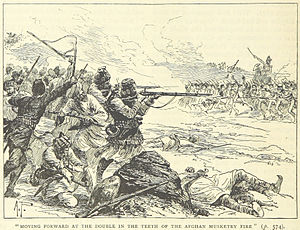The Battle of Jalalabad in 1842 was an Afghan siege of the isolated British outpost at Jalalabad, about 90 miles (140 km) east of Kabul during the First Anglo-Afghan War. The siege was lifted after five months when a British counterattack routed the Afghans, driving them back to Kabul.
| Battle of Jellalabad | |||||||
|---|---|---|---|---|---|---|---|
| Part of the First Anglo-Afghan War | |||||||
 The British troops (right) attack the Afghan line (illustration from a British book) | |||||||
| |||||||
| Belligerents | |||||||
|
|
Afghan tribes | ||||||
| Commanders and leaders | |||||||
|
|
| ||||||
| Strength | |||||||
| Unknown, but outnumbered[1] | Unknown, but outnumbered the British[2] | ||||||
Battle
editThe outpost was no more than a wide place in the road with a fort, held by about 2,000 troops under General Sir Robert Sale. After the massacre of the British force during their retreat from Kabul in January 1842, Jalalabad was surrounded by Afghan forces, which launched a series of attacks on the force. The British managed to beat off the assaults, and even captured 300 sheep from the besieging force when rations ran short. Eventually, after five months under siege, Sale mounted an attack against the Afghan forces on 7 April. The British captured the main Afghan camp along with all the baggage, stores, guns, and horses. Driven in a rout the Afghans fled to Kabul.
The following day George Pollock's Army of Retribution arrived, to be played into Jellalabad by the band of the 13th with the Scottish song "Oh but you've been a lang time acoming."
Aftermath
editThe defence of Jalalabad made heroes of the 13th Foot (later known as the Somerset Light Infantry). It is reported that as the regiment marched back through India to return to Britain, every garrison fired a ten gun salute in its honour. Queen Victoria directed that the regiment be made Light Infantry, carry the additional title of "Prince Albert's Own" and wear a badge depicting the walls of the town with the word "Jellalabad".[citation needed] The army barracks in Taunton, the county town of Somerset, was named Jellalabad Barracks after the battle and that area of the town is still known as 'Jellalabad'.
W. L. Walton a landscape artist, working in London, who exhibited between 1834 and 1855, made the lithographic plates for General Sale's Defence of Jalalabad (c. 1845).[3]
Order of Battle
editThe British order of battle was;
British Army
Bengal Presidency Army
- Squadron from 1st Horse (Skinner's Horse)
- 35th Bengal Native Infantry
- Shah Shujah's Sappers
- Artillery troops from the Bengal Field Artillery
Notes
edit- The Free Dictionary by Farlex Archived 2012-02-04 at the Wayback Machine
References
edit- ^ Dalrymple, W. (2013). The Return of a King: The Battle for Afghanistan. Borzoi book. Bloomsbury. ISBN 978-1-4088-1830-5. Retrieved 15 June 2020.
...even though the garrison was by then outnumbered at least three to one by Akbar's huge army of Ghilzai and Shinwari tribal levies.
- ^ Dalrymple 2013: "...Even though the garrison was by then outnumbered at least three to one by Akbar's huge army of Ghilzai and Shinwari tribal levies.
- ^ "W. L. Walton and General Sale's Defence of Jalalbad (c. 1845)". Leicester Galleries. Archived from the original on 2 February 2017. Retrieved 21 January 2017.